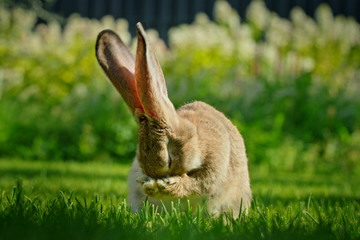Safe Rabbit Holding Techniques - It Matters!
Your furry little friend is so adorable, you just want to hold her all day long! But holding a rabbit is nothing like holding a dog or cat. Because rabbits are prey animals, they are naturally wary of being picked up. They also have delicate skeletal structures that require gentle handling. If a rabbit feels unsafe or unsupported, she may kick hard enough to injure herself.
Click Here For a Beginners Guide to Rabbit Care.

That doesn't mean you can't safely pick up and hold your bunny! Learning proper rabbit holding techniques can help build trust and deepen your bond. Whether your rabbit enjoys being held or is a bit nervous, following the right approach can make all the difference.

Let's explore how to safely pick up, hold, and handle your rabbit while keeping her comfortable and secure.
Understanding Your Rabbit’s Instincts
Rabbits are naturally skittish creatures. In the wild, they are prey animals that stay low to the ground to avoid predators. Being lifted into the air can feel terrifying, as their instincts tell them they are in danger. Some rabbits may freeze, while others may try to jump, kick, or twist to escape.
Because of this, it's important to introduce handling slowly and positively. With patience, your rabbit can learn to tolerate – or even enjoy – being held.
6 Tips for Safe Rabbit Holding Techniques
Before picking up your rabbit, ensure she is calm and comfortable. Here are six essential steps to follow:
Approach your rabbit at her level. Rabbits are easily startled. Instead of reaching down from above, get down on the floor with her. Let her see and sniff your hands before you attempt to pick her up.
Give your rabbit a few pets first. Most rabbits enjoy being petted on their heads and around their ears. Spend a minute stroking your rabbit to help her relax before lifting her.
Slide one hand under her chest. Position your hand so your fingers are under her armpits, supporting her upper body. This step helps prevent sudden jumps.
Gently lift your rabbit while supporting her hind end. As you lift, place your other hand under her bottom. Rabbits feel more secure when their back legs are supported.
Hold your rabbit against your chest. Bringing her close to your body will help her feel safe. Make sure her legs are tucked in, and keep a firm (but gentle) hold.
Put her down carefully. Lower her gently When your rabbit is ready to be put down. Always let her hind feet touch the ground first, preventing injury from jumping too soon.
How to Hold a Nervous or Wiggly Rabbit
Not all rabbits enjoy being held right away. Some may struggle, kick, or try to leap from your arms. If this happens, don't panic. Instead, try these techniques:
Practice short handling sessions. If your rabbit dislikes being held, start with brief interactions. Lift her just an inch off the ground, then put her back down. Gradually increase the time as she becomes more comfortable.
Use a secure hold. If your rabbit struggles, hold her firmly (but not too tightly). A loose grip may allow her to wiggle free, while too much pressure could cause stress.
-
Stay calm. Rabbits are sensitive to emotions. Your rabbit will pick up on it if you are nervous or tense. Speak softly and move slowly to help her feel at ease.

Common Mistakes to Avoid
When learning rabbit holding techniques, it's just as important to know what NOT to do. Here are a few mistakes to avoid:
Never pick up a rabbit by the ears, scruff, or legs. This is painful and can cause serious injury.
Avoid holding your rabbit on her back. This position, known as "trancing," can cause extreme stress.
Do not let your rabbit jump from your arms. A high fall can result in broken bones.
Never chase your rabbit to pick her up. This can make her fearful of you.
What to Do If Your Rabbit Hates Being Held
Some rabbits simply do not like being held. If your bunny consistently resists, focus on building trust through other means:
Spend time sitting near her, allowing her to approach you on her own terms.
Offer treats and positive reinforcement when she interacts with you.
-
Use a pet carrier for transport instead of picking her up.

Aggressive Rabbits and Handling
If your rabbit growls, lunges, or bites when you try to pick her up, there may be an underlying reason. Here's what to consider:
Hormonal aggression: Unspayed or unneutered rabbits can be territorial and aggressive. Spaying or neutering can significantly improve behavior.
Past trauma: If your rabbit had a negative experience with handling in the past, she may be fearful. Work on trust-building exercises before attempting to hold her.
Health issues: Pain or discomfort can make rabbits react aggressively. If your rabbit suddenly becomes aggressive, a vet check is recommended.
Final Thoughts
When done correctly,Holding your rabbit can be a wonderful bonding experience. By understanding her instincts, using gentle techniques, and respecting her comfort level, you can make handling a positive experience for both of you.
Are you new to rabbit care and curious about other rabbit basics? Download our Rabbit Starter Kit today to learn more about feeding, grooming, and handling your bunny the right way!

"Why Is My Rabbit Licking Her Own Pee?"

Rabbit Is It Low Maintenance or More Work Than You Think?

Tips to Manage Rabbit Chewing Habits







